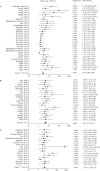A Systematic Review and Meta-analyses of the Clinical Epidemiology of Carbapenem-Resistant Enterobacteriaceae
- PMID: 29038269
- PMCID: PMC5740327
- DOI: 10.1128/AAC.01730-17
A Systematic Review and Meta-analyses of the Clinical Epidemiology of Carbapenem-Resistant Enterobacteriaceae
Abstract
Carbapenem-resistant Enterobacteriaceae (CRE) are major health care-associated pathogens and responsible for hospital outbreaks worldwide. To prevent a further increase in CRE infections and to improve infection prevention strategies, it is important to summarize the current knowledge about CRE infection prevention in hospital settings. This systematic review aimed to identify risk factors for CRE acquisition among hospitalized patients. In addition, we summarized the environmental sources/reservoirs and the most successful infection prevention strategies related to CRE. A total of 3,983 potentially relevant articles were identified and screened. Finally, we included 162 studies in the systematic review, of which 69 studies regarding risk factors for CRE acquisition were included in the random-effects meta-analysis studies. The meta-analyses regarding risk factors for CRE acquisition showed that the use of medical devices generated the highest pooled estimate (odds ratio [OR] = 5.09; 95% confidence interval [CI] = 3.38 to 7.67), followed by carbapenem use (OR = 4.71; 95% CI = 3.54 to 6.26). To control hospital outbreaks, bundled interventions, including the use of barrier/contact precautions for patients colonized or infected with CRE, are needed. In addition, it is necessary to optimize the therapeutic approach, which is an important message to infectious disease specialists, who need to be actively involved in a timely manner in the treatment of patients with known CRE infections or suspected carriers of CRE.
Keywords: Enterobacteriaceae; carbapenem; meta-analysis; resistance; risk factors; systematic review.
Copyright © 2017 American Society for Microbiology.
Figures




References
Publication types
MeSH terms
Substances
LinkOut - more resources
Full Text Sources
Other Literature Sources
Medical

